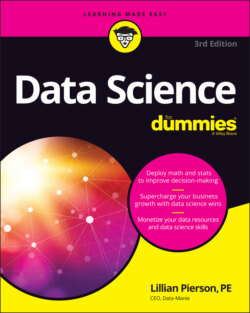Читать книгу Data Science For Dummies - Lillian Pierson - Страница 26
Defining Big Data and the Three Vs
ОглавлениеI am reluctant to even mention big data in this, the third, edition of Data Science For Dummies. Back about a decade ago, the industry hype was huge over what people called big data — a term that characterizes data that exceeds the processing capacity of conventional database systems because it’s too big, it moves too fast, or it lacks the structural requirements of traditional database architectures.
My reluctance stems from a tragedy I watched unfold across the second decade of the 21st century. Back then, the term big data was so overhyped across industry that countless business leaders made misguided impulse purchases. The narrative in those days went something like this: “If you’re not using big data to develop a competitive advantage for your business, the future of your company is in great peril. And, in order to use big data, you need to have big data storage and processing capabilities that are available only if you invest in a Hadoop cluster.”
Hadoop is a data processing platform that is designed to boil down big data into smaller datasets that are more manageable for data scientists to analyze. For reasons you’re about to see, Hadoop’s popularity has been in steady decline since 2015.
Despite its significant drawbacks, Hadoop is, and was, powerful at satisfying one requirement: batch-processing and storing large volumes of data. That's great if your situation requires precisely this type of capability, but the fact is that technology is never a one-size-fits-all sort of thing. If I learned anything from the years I spent building technical and strategic engineering plans for government institutions, it’s this: Before investing in any sort of technology solution, you must always assess the current state of your organization, select an optimal use case, and thoroughly evaluate competing alternatives, all before even considering whether a purchase should be made. This process is so vital to the success of data science initiatives that I cover it extensively in Part 4.
Unfortunately, in almost all cases back then, business leaders bought into Hadoop before having evaluated whether it was an appropriate choice. Vendors sold Hadoop and made lots of money. Most of those projects failed. Most Hadoop vendors went out of business. Corporations got burned on investing in data projects, and the data industry got a bad rap. For any data professional who was working in the field between 2012 and 2015, the term big data represents a blight on the industry.
Despite the setbacks the data industry has faced due to overhype, this fact remains: If companies want to stay competitive, they must be proficient and adept at infusing data insights into their processes, products, as well as their growth and management strategies. This is especially true in light of the digital adoption explosion that occurred as a direct result of the COVID-19 pandemic. Whether your data volumes rank on the terabyte or petabyte scales, data-engineered solutions must be designed to meet requirements for the data’s intended destination and use.
When you’re talking about regular data, you’re likely to hear the words kilobyte and gigabyte used as measurements. Kilobyte refers to 1024 bytes, or 210 B.) A byte is an 8-bit unit of data.
Three characteristics — also called “the three Vs” — define big data: volume, velocity, and variety. Because the three Vs of big data are continually expanding, newer, more innovative data technologies must continuously be developed to manage big data problems.
In a situation where you’re required to adopt a big data solution to overcome a problem that’s caused by your data’s velocity, volume, or variety, you have moved past the realm of regular data — you have a big data problem on your hands.
